We’re going to cover a few lower body and upper body plyo exercises that you can do to improve your ability to jump higher, run faster, be more explosive, and to tone those legs. First, we have to talk about plyometrics.
What exactly is PLYO
What does it mean? You can refer to plyometrics as explosive exercises. These are workouts that consist of fast, sensitive, powerful movements. They are generally used by athletes who want to improve their sports performance.
But today they are increasingly popular by people who want to stay in shape and to tone up.
Benefits of Plyo Exercises
Plyometrics helps with activities such as jumping higher, running faster, throwing further and harder, and hitting harder. With that kind of variety, it’s crucial to develop a plyometric workout routine that will cater to your needs. Because if you want to throw further or harder, hit harder, that may not be the same needs as someone who wants to jump higher or run faster. Thus, your plyo workout routine depends on what your ultimate goal is. Keep that in mind.
What about if you here as just a high jumper or if you’re a sprinter. And you want to target your lower body specifically. Should you stick to lower body plyometrics only? My answer to that is. Think about it this way. When you’re jumping, are you using your arms? Do you have an arms lock? When you’re sprinting, are you throwing back your elbows? The answer is yes. You’re actively using your entire body almost. You’re using your arms, legs, core. My advice for that depends on what muscle group you use most. Sprinters and jumpers, even though you’re using arms, you’re mostly using your lower body. That is why you should stick to primarily lower-body plyo training.
However, I would not eliminate upper body plyometrics from athletes such as sprinters and high jumpers. Why? Because, as I said, you’re doing the arm block, you’re using your arms. Those are important factors to determine how successful you are going to be with your event. Especially once you start peaking, you’re trying to figure out ways to improve.
One of the critical factors might be that your arm movement was lacking. And now, if you have a more powerful arm drive, you can generate some more power through your arms. So, look at your ultimate goal. And that’s going to be the determining factor of what workouts you will concentrate.
Additional benefits of plyometric exercises include:
- Increase Explosive speed
- Improved agility
- Greater leg strength
- Faster hill running
- Higher Vertical Leap
- Building stronger bones
- Strengthen the Cardiovascular system
- Tone your muscles
- Improved coordination
Most Common Questions
Okay, now let’s answer some FAQs.
Who invented PLYO?
Professor Yuri Verkhoshansky invented plyometrics. He developed plyometrics in the 1950s. Yuri is considered to be one of the most excellent experts in the field of sports theory. He’s also a prominent researcher in the field of explosive strength.
Is plyometrics just lower body?
No! Upper body plyos can be performed too.
Do you need equipment for plyos?
Plyo training can be performed with or without equipment. Some equipment that will aid us in plyo exercises includes boxes, medicine balls, and hurdles.
Who should be doing plyometrics?
Who shouldn’t be doing? It’s just about for everyone. It’s for people who want to tone up. It’s for athletes. It’s just about any person. It’s for you.
But if you have any biomechanical deficiencies, make sure you consult a doctor or an expert trainer. There are chances that you may get injured. These are high impact exercises. If you have weak knees, then you might want to strengthen them before you get started with plyos. Do some lightweight, easy exercises, such as non-weighted lunges, get a box, and do step-ups. Make sure you have a good solid foundation before you get deep into plyometrics. You don’t want to get injuries.
How many sets and reps should I do?
If you’re an athlete, your goal here should be quality over quantity. But if you’re someone who wants to get in shape and burn off some calories, then go ahead, go for numbers. But at the same time, be aware of your technique.
Can you wear ankle weights or a weight vest when you’re doing plyometrics?
You can, but would it be smart? Ankle weights can cause injury if they’re not used properly. I don’t recommend ankle weights. The only reason I’ll use ankle weights is doing knee raises hip flexor exercises. But I never wear ankle weights to walk around the whole day. And that’s something I did as a kid. I do not recommend anyone to do that. I mean, it was fun when I was a kid. When you take off the ankle weights, you feel like you can fly. You have to load a weight off your ankles, and it just feels fantastic. But it’s not smart to think long term. If you want to last long, then I would stay away from it.
I would recommend weight vest instead of ankle weights. But I still wouldn’t advise wearing a heavyweight jacket during plyometrics. If you want to wear it, get a weight belt. If anything, I would recommend that. But even that, I wouldn’t also use it during the plyometric workout. Maybe a couple of pounds but not too heavy.
Can I lift weights and get the same results as plyometrics?
Maybe. Some people can pull it off. But for most of us, we can significantly benefit from plyos. Why would you want to limit yourself? When you can do plyometrics and lift weights. Can you see how that can add up? You can be the ultimate athlete if you take advantage of all the different resources and knowledge that you acquire. I would recommend doing both weight lifting and plyometrics.
What can you do to prepare for plyometrics?
That all depends on where you stand in terms of physical fitness level. If you’re a beginner new to the workout environment, then you should start with a basic aerobic workout program. Get your stamina up, your endurance. Start with some light exercises, some basic strengthening exercises, and flexibility routine. Make sure that you have a basic workout that integrates strength, flexibility, and aerobics.
You don’t have to be in crazy endurance shape to do plyo movements. I don’t advise you to go on running a marathon distance for plyometrics. That’s one of the last things you want to do. But it’s just right to have a certain level of endurance when you’re doing these exercises.
Are plyometric exercises good for weight loss?
If you’re overweight and you want to do plyometrics, I would strongly advise you to lose some weight before you start even doing plyo training. The extra weight that you carry will be some rough impact on your joints. When we’re doing plyometrics, and we’re landing, we want to make sure that we can land as graceful as possible. We want to land quietly. And usually overweight people have some rough landings. You can hear a loud sound when they fall. And that’s inefficient. You’re hurting your joints, and it’s just rude. You don’t want to be in that position. Anyway, it doesn’t mean that you can’t do plyo exercises. You have to go a little bit lighter. You can’t do some of the more advanced practices just yet.
But if you stick in there, you’re going to shed those pounds. And then you’re going to start doing the more advanced exercises. So, hang in there, but keep that in mind, please.
To prepare for plyometrics, I also advised it with some basic drills and exercises. Such as high knees and butt kicks and all sorts of track and field drills. These exercises are great.
Upper body exercises
Upper body plyos are an excellent pace changer, great variation to use in conjunction with your upper body days. We like to use our body plyos after our strong core pressing movements. That’s a bench press or a push press whatever our movements are for that day.
Plyometric Push-ups on plates
The first exercise is just a basic plyo push up on top of plates. We like to start with the hands inside the plates. Come down into a push-ups position. Accelerate up quickly and hit the plates with a slight eccentric on to the triceps. We try to land on almost straight arms. Pause the top. Come back down. Explode off the plates. Land in the center. It’s an excellent opportunity here to blow up your triceps.
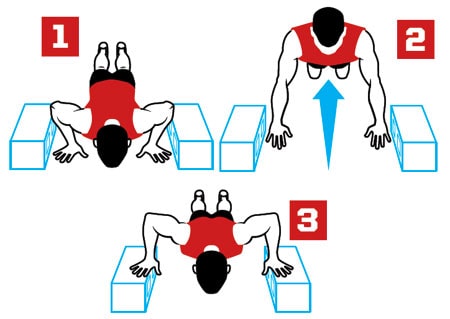
Alternating-arm plyo push-ups (plates)
The second variation for a plyometric push-up would be an alternate arm.
Come down into a push-up position.
Explode up off of that inside arm.
Try to land with both hands at the same time. So both: the hand hit the plate and the other hand hit the ground at the same rate.
Try to get maximized the height of the plate.

Plyo push-ups on a medicine ball
If you don’t have plates, another excellent opportunity to incorporate plyos is with a med ball.
We can start with a similar type by lateral movement. Both hands on top of the med ball.
Come down into a push-up position.
Explode up and land with the hand outside of the med ball.
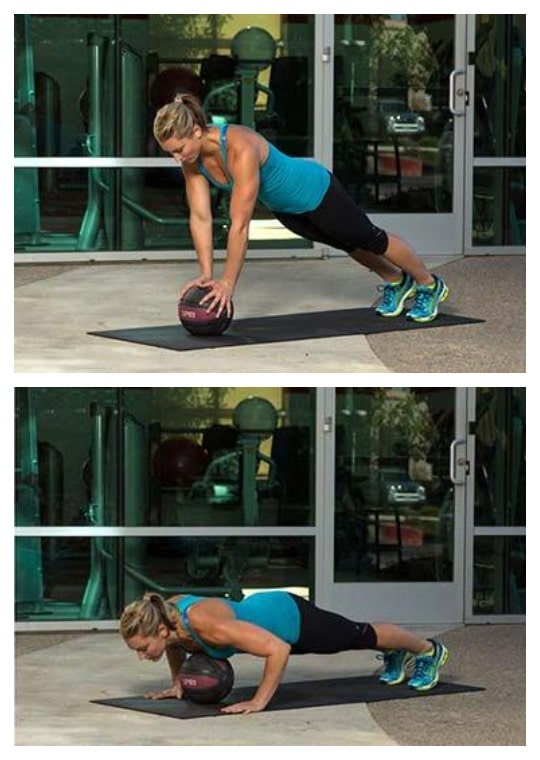
Alternating-arm push-up (med ball)
With the ball, you have a little bit of an additional challenge with the stability. The unstable surface always seems to complicate things.
Bosu ball plyo push-ups
Another variation would be on a BOSU ball.
Come down to do a push up on a BOSU ball.
Explode up off-net. Bring the ball into your chest.
Try and land back on straight arms.
Come down, do the push-up.
Explode up. Pull the ball to your chest and on straight arms.
You get that excellent eccentric on the triceps.
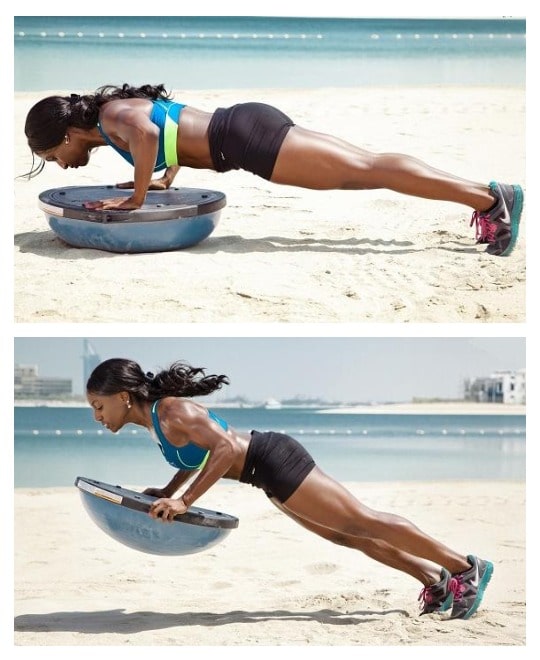
Power drop (medicine ball)
Another reasonable exercise we call a power drop. Try to limit the amount of time when the ball makes contact with the hand. Be very reactive to it. Load up off the chest. Try not to blow all hit the chest.
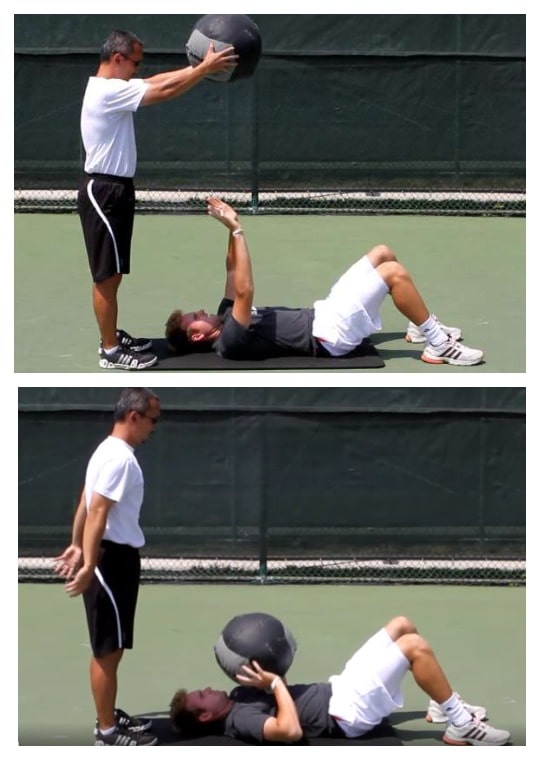
Pushup Hop From Knees
We’re going to do a push-up with the triceps push-up with a plyo solution. Start on your knees; if you can, you can go on your toes. Go on your knees. Go down. Perform a tricep push-up. Jump up. Go to regular, changing your grip.

Ball Chest Pass
Plyometric chest throw into the wall while standing. Make sure that you’re standing. Root yourself. Reach through the wall explosively. Make sure that when you throw, you don’t throw yourself out of control.
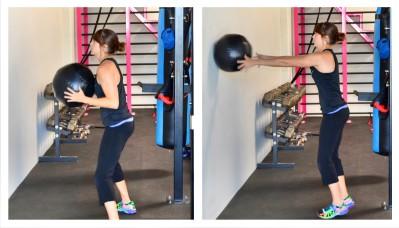
Wall Ball
This exercise is great. The idea of a lot of athletic and sports performance training is a dynamic hip hip extension. The ability is to go from a flexed position of the hip to dynamically extending it. It is widespread in all sports. Along with that, we’re also establishing control and accuracy training with the upper body.
How to do
Start with a medicine ball at your chest nice and high. The idea is to kind of cup your elbows underneath it. Hold the ball. When you go through repetitions, and your elbows are out, the weight will start to fall. That is why try to keep your elbows nice and tight underneath it and the ball nice and high. Probably in line with the upper portion of your chest and your chin.
Set up to a wall a few feet away from the wall. The idea is the volatility bouncing off of the wall, and they’re coming back down to you. Go to perform a deep squat but back on your heels. Notice again where your spine is aligned. You’re not blocking forward. You’re also not just doing a mid squat. You want to generate as much force through your hips as you possibly can get into a deep squat. From there, you’re dynamically standing up. Sometimes we will even jump into this. Throw the medicine ball most commonly (10 feet for men, 9 feet for women) up against the wall. Back down. Back into your squat.
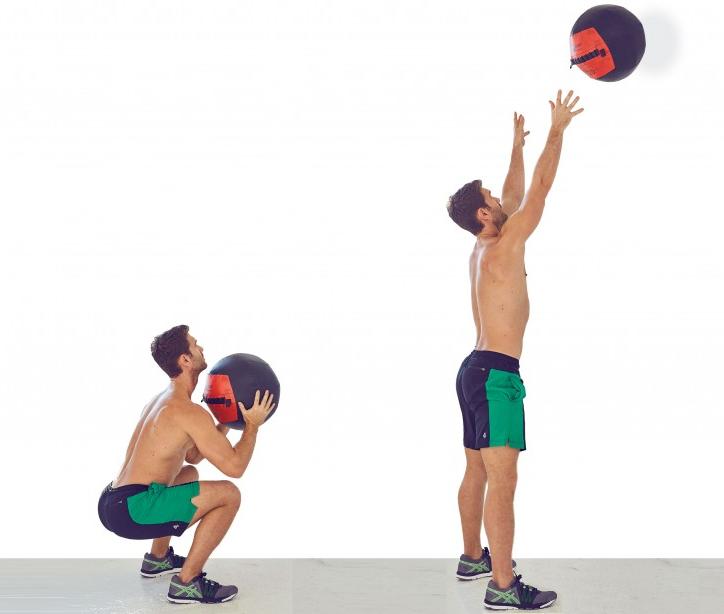
Few of the most common mistakes:
1) You’re allowing the ball to control your torso. A lot of times, you’ll see the ball come back down, and it’ll pull the body forward like so. It’s put a lot of stress on your lower back. What is why always keep that strong spine.
2) You’re not squatting far enough. For some sport, you want to be able to use dynamic hips to the biggest range of motion possible. Often I see people popping up like this. You want to avoid that limited range of motions.
3) Catch. A lot of times, I see people just sort of catch the ball on their hands. Again, if the weights too heavy for you to catch comfortably like so, use a lighter weight. You don’t need to use a 50-pound medicine ball right like that. You want to make sure you’re catching it in this good structured, stable position. At the same time, you’re not letting the ball pull you down. Since you’re not using heavyweight in general, it would be kind of higher rep ranges.
I like to incorporate this style of movement into it’s a metcon aspect of things be the metabolic conditioning (or what crossworld called a WOD). I’d probably keep it in the 10 to 15 that range.
Ball Slam
Standard ball slam. We’re bringing our slam ball from overhead, and we’re releasing it as soon as we get close to the floor. You don’t want just to take it from overhead and drop it. You want to have a proper contraction. You are coming all the way through and engage that into your core.
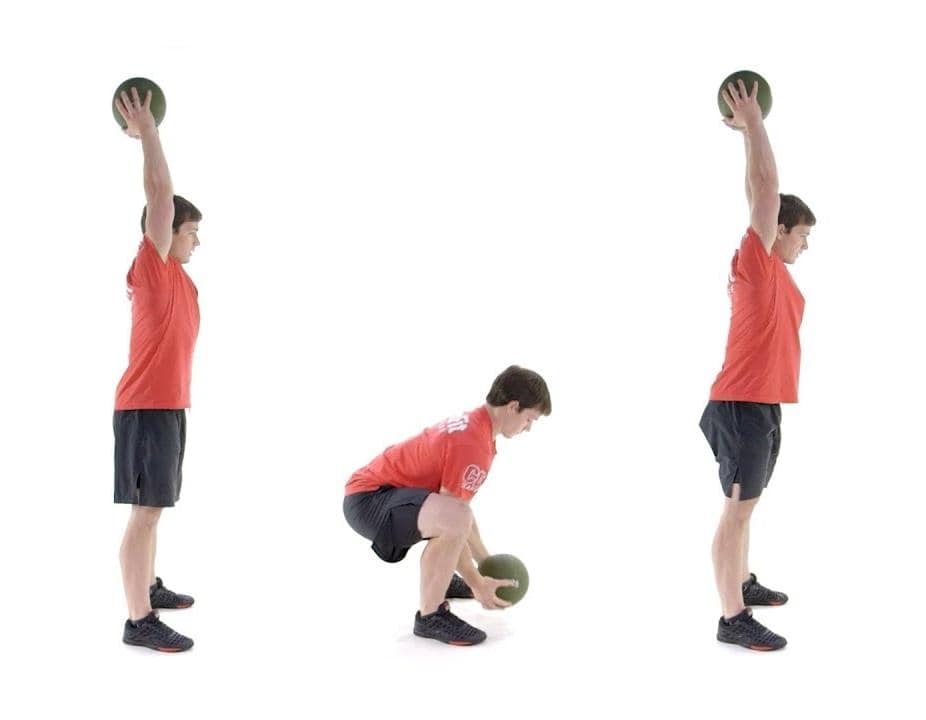
Rotational ball slam. We’re doing a very similar thing except at the top; we’re starting with a rotational movement, and then we’re coming down. It’s almost like you’re swinging an ax or a hammer. We’ll see a little off-balance from one side to the other. We’re coming overhead all the way through and releasing at the bottom point in the movement.
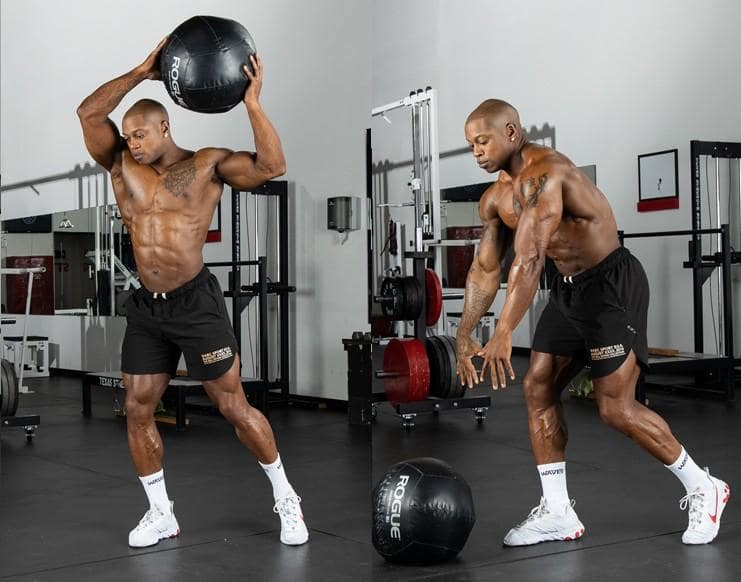
Incorporating upper body plyometrics is a great way to vary your workouts. We like to change the pace a little bit. We combine the upper body plyos after the massive core pressing movement. When we transition from moving a hefty load at a slower rate and acceleration to moving a light load. Often body weight and very rapid acceleration change up signals to the muscles. It helps with the strength and power development component as well as some sub hypertrophic qualities.
Core
These are plyometric exercises for Abs
Mountain Climbers
That is a great plyometric exercise, which also includes a perfect cardio element. It’s an excellent exercise to throw in between other activities to keep that heart rate elevated. Squat down and put your hands on the ground. Assume the starting block position. Make sure to keep your butt down and abs tight as you switch positions of your legs. Make sure you keep that butt down and those abs tight.

Plank Jacks
Get into the plank position on your elbows. Feet are going to be touching in line with your body.
Drop down. Feet together. Right angle. At the same time, spread your legs out as wide as you can well while staying on your toes. Then bring them back in, if you can speed it up it all the better. While you are maintaining, nice straight back.
Keep your body flex the entire time. Make sure that the butt stays in the same place. It’s not going down, and it’s not moving up.
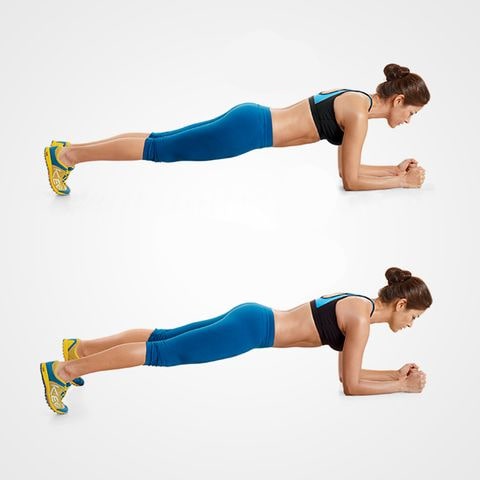
Plank Tucks
This exercise is going to engage your abs as well as to get your heart rate elevated and burn a ton of calories while you’re at it.
Get set up in a plank position on your hands. Your wrists will be underneath your shoulders. The upper body is nice and robust. Act like you’re pushing the floor away with your upper body. Your body should be in a nice, super straight line when your hips down in line with the rest of your body.
From here to start your timer, you’re going to be jumping your feet. Into a bit of a crouching position, like you’re going into a little bit of a tuck ball. Then drop it back out into that straight position.
You can do steps to modify quick movements. Hips are staying in line. Work to your maximum capacity. For the duration of a one-minute timer, make sure that you’re productive. However, you need to do it if you can cycle back into a few of these jumping reps. Then modify back times your step; you can alternate between the two. Make sure you’re pushing your hardest.
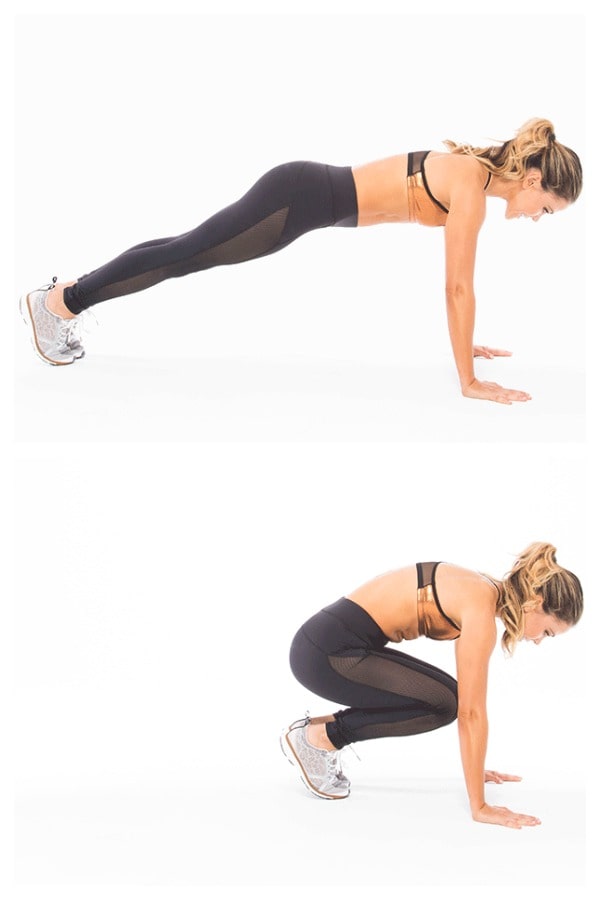
Side-to-Side Plank Hop
Get into a plank position. Elbows and feet. Make sure your plank is straight. Jump both feet at the same time to either side. Make rotating coming back to the middle. To the right, to the center, to the left, and repeat.

Donkey Kicks
This exercise is going to fire up your shoulders, triceps, chest, back muscles. Also, your entire core, which is your lower back and your abdominals and obliques.
Here are some modifications which anybody can do. Go down on a little angle, go into a plank. Go to walk a little bit. Make sure you don’t step backward, but you walk over your hands. It’s almost like you’re trying to do a handstand. Shoulders are over your hand, and you are going to pull your heels to the butt. This movement is going to engage your core, making your shoulders lower back.
You can hop one, or you can hop two. Also, you can jump over a little imaginary line. You could put a towel on the floor, or you can hop over.
Donkey Kick Jumps is a great upper-body and core strengthener. It’s fires for everything. Your heart rate will come up. Don’t sacrifice form by pushing backward. You want your weight over your hands. That way it’s almost like you’re doing a handstand or a handstand against the wall.
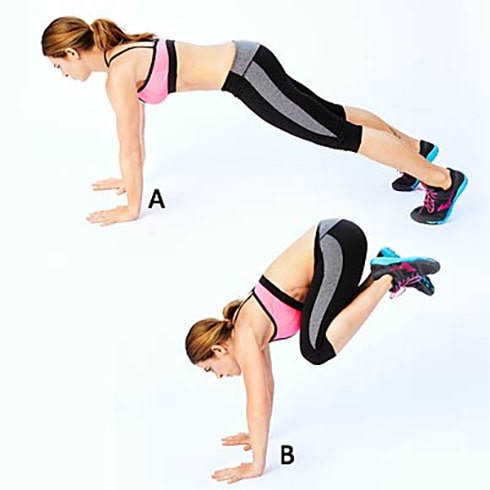
Lower Body
Here are lower body plyometric exercises can be used to develop power in your legs.
Jump-off Box Landings (Depth Jumps)
The depth jump is one of my favorite exercises to increase your vertical jump. Stand on something about 18-30 inches high, depending on how advanced you are. Lean off. Jump as high as you can. Then reset your walk back off. You’re not coming down and going low. You are merely hitting the ground, doing a quarter squat, exploding as high as you can get. If you want to do a more advanced version, you want to make it a little bit harder. When you land, you’re going to fall into a lunge. Hold that launch for 3 seconds. That’s teaching your body how to absorb energy naturally. It’s going to help your vertical jump. It’s going help you add those stubborn inches that you’ve been trying to get.
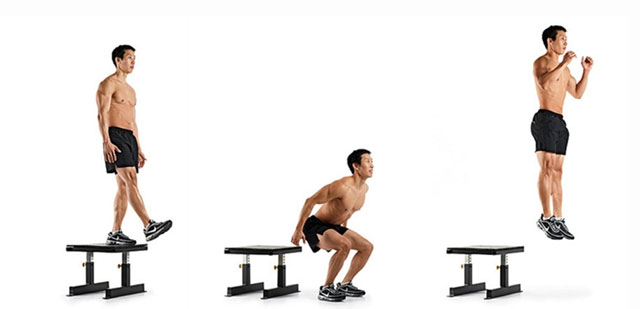
Box Jump
Here a couple of basic jumps that you need to include in your plyometric workout.
The traditional box jump is just squaring up to the box, jumping up, stepping down. Make sure you’re pushing off the ground evenly, you’re landing in the center of the box softly. Sometimes people make a mistake. They are jumping down off the box. There’s no purpose in jumping down unless it’s controlled, which is depth jump.
Here basic jump. Square up to the box. You want to get it about two feet off the box here. Use those hands counter-movement down. Propel yourself up to the box and stand up. Don’t jump down. Save your knees. Remember when you’re going for plyometric box jumps, you’re going on speed and power. Now power is just speed and strength combined. You want to be doing is getting off the ground fast, leaving pushing powerfully enough to get onto that box. You’re going to be generating a lot of good vertical and horizontal power to get you jumping higher, to get you off the line faster.
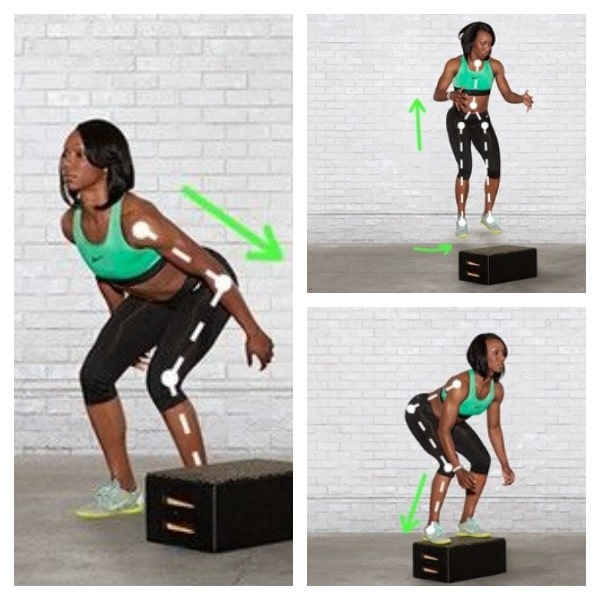
The twisting box jump is more complicated. It is an excellent rotational exercise. Stand perpendicular to the box. Squat down and then propel yourself forward. You are pushing off that outside leg twisting, landing on the center of the box. Take your time with this one. It is a more advanced movement.
Lateral Skater Jumps
You’re just going to jump side to side. Take a speed skater. You want to make it fluid. When you land, you want to bend your knee immediately. Your back foot is just in the air, and you’re just fluid beside side.
How could we possibly do this wrong?
If you spread your legs, you should be jumping slightly further in the distance of what you’re comfortable standing in a wide stance. If you jump narrower that, then you’re not getting the goal of the exercise.
Try to jump further than a wide stance position. Your goal should be to jump, land, and catch your balance. Don’t take a bunch of stutter steps once you land. If you can’t help it at first, that’s fine, but remember, your goal is to jump and stick that landing.
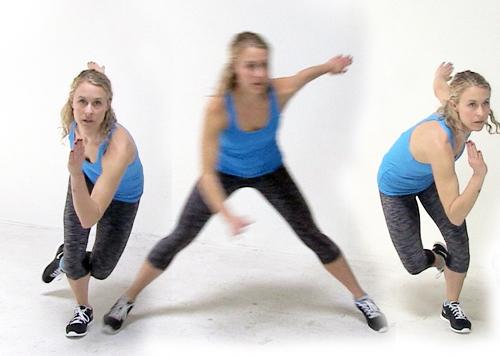
Banded Broad Jump
Band resisted broad jumps much better than a regular broad jump because there isn’t as much pounding down on impact. We can use it without worrying about lower extremity injuries and lots of crazy soreness. We’re going to use a 1 1/8 inch band. Wrap it around whatever you have that’s a solid object you can attach it. Step out to the point of a little bit of tension. Your feet are just about hip-width apart. It’s not slightly inside of that. You should stay in line with your hips when you jump — the same thing on land. Back into your hips and then get out nice and far. Think of it as a more horizontal movement, not vertical.

Squat Jump
This exercise starts basic and advances into more power and agility packed movement. Start in a primary squat position. Feet shoulder width apart, back straight, head forward, and arms extended out in front of the body. Squat down as if you were going to sit into a chair and then stand up. Repeat 4 to 6 times.

Now you are ready to advance. Squat down and explode the body up, jumping off the ground and landing back down into a squat position Then repeat. Complete 2 sets of 12 reps, building to 3 sets.
Jump Rope
Fantastic convenient plyometric exercise. It’s old-school stuff. It’s a lot tougher than it looks. It helps your rhythm, get your heart rate up. It travels very easily. You can throw this in your pocket as you travel. You don’t need hardly any room at all for it.
Most people should be able to start with 50 jumps. I like to go for a hundred two for a basic jump. Real important is to try to land softly. Think soft like a cat. Then once you get this, you can go a little bit faster. I usually do 150 of these in the morning two or three times. It’s an excellent way to get the blood full and waking up. Try to skip and alternate left right feet. Get those knees nice and high. If you mess up, don’t get down about it. Start right back again. Once you get the rhythm for the first half, then try to pick up the tempo. If you pick up the tempo, you get in a 100-125. It’s effortless to get that heart rate around 150, 160, 170.
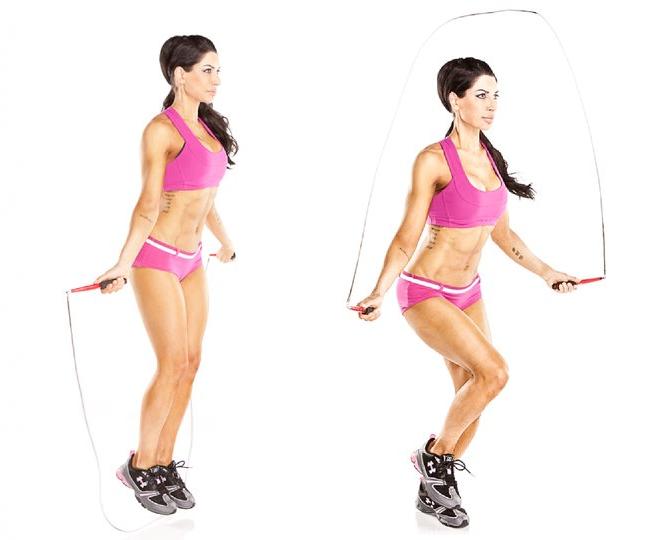
Exercises for Runners
How to run faster. Jump higher, with only a little effort. You need to keep in mind a few things. To run quicker, you should incorporate a few sprints into your general daily practice. So choose one to two days out of every week that you will do sprint work. Also, mark off 220 yards on your distance. Start from one end and keep running as quickly as possible. At that point, stop, take a one-minute break. Repeat the sprint once more. After some time practicing, that amount of time that it takes for you to be able to run 220 yards will reduce. You will speed up. So try to do that around 1-2 times each week.
Vertical jump
To jump higher, you must incorporate some plyometric practices into your general schedules. Build up your legs through strength training.
Start with a vertical jump, which is an excellent example of plyometrics movements.
Stand up next to a wall. Bend your knees. Jump up as high as possible, and contact the wall. Have someone with you to note, where was that you reached the mark. After that, go after much higher when you have that market there. Practice the jump movement during the week.
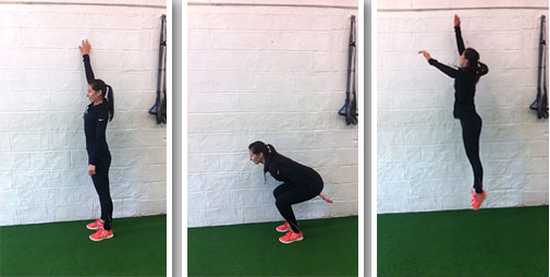
Knee Tuck Jump
Another plyometric exercise is knee tuck jump. It`s a significant explosive movement. Bend your knees, and after that jump, bringing your knees up to the chest. Do 10 of those in a row. Rest 1 minute. Perform ten more. Complete 3 sets.

Mountain climber
Mountain climbers another plyo exercise to work those legs. Perform a 1 minute. Rest for around 30 seconds — complete 10 sets of those.
Running stairs

The last great way to increase your speed and power ultimately is a running stairs. Go to a stadium, look at those seats. Try to climb high and fast.
Plyo Exercises For Beginners at Home
Doing plyometrics for beginners, we want to think about conditioning and strengthening our feet initially, because those explosive movements take a lot of body conditioning. We don’t want to get too impactful when we first start. We’re going to do everything at an easy pace. Not too explosive, just like had mentioned. We’re going to think about building strength in our feet and our legs.
Jump Roping
We start with a jump rope, which is a great way to strengthen your feet. With the jump rope, you can do some nice, easy jumps.
With this workout, you can do anywhere from 15-30 seconds of work, with 30 seconds of rest. Think about staying on the balls of your feet and just a nice, easy pace. Jump rope is great for that. It’s wonderful for cardiovascular, too.
You can also do what’s call invisible jump rope. Where you have an invisible jump rope. You’re still getting that same motion and movement and strengthening in your feet.
Ice Skaters
For this exercise, you can use any marker or not. You can put anything down on the ground. It’s is a lateral movement, which is great for everybody. What you’re going to do is, you’re just going to do nice, little hops off to the side.
You could put a foot down to stabilize more if you need to. And the stronger your legs get, you can get a little bit more explosive. Also, think about bending down a little bit. Because that will help work your legs here, too. Strengthening your legs is our goal for beginners. Once again, you can do 15-30 seconds of work, 30 seconds of rest. It’s going to get your heart rate going.
Frog Hops
Next, we’re going to go into what I call frog hops. For beginners, don`t hold any weight. Eventually, when you get stronger, you can hold a medicine ball or any magazines at home.

Start low. We’re going to start working on building strength through a fuller range of motion with these. Jump up, high as you can, but sitting back through your heels and using your glutes to jump up explosively. Try to hop up and go as low as you can. Because that’s what plyometrics is all about. Building cardiovascular strength, endurance. Once again, 15-30 seconds work, 30 seconds rest if you need that much rest.
Marker Jumps
Whatever you have at home, you can put on the ground. We’re going to keep it low, so we don’t have to jump too high. We’re just going to be doing some two feet jumps. Just a nice jump. Stay on the tops of your toes for this. And it doesn’t even have to be fast. Eventually, you can get faster, that’s great. It’s not about the speed initially.

Super great for your heart rate, great for balance. Especially as we get older, our balance starts to get a little – not as good as it used to be.
Now, we can go lateral, too. So we’re just hopping laterally. Think about using your arms, which help your body go up in the air.
We’re going to jump slow and controlled. Eventually, if you want to get going a little faster, you can do that, but this is beginning. We’re just controlling our movements.
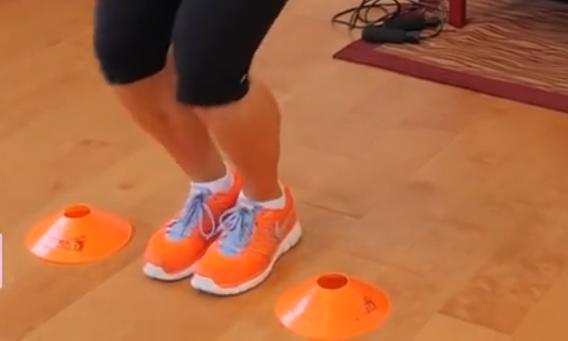
These are four, really great, plyometric exercises for beginners. Do as much work as you can. If you can push it to 30 seconds, take that 30 seconds rest. Then go right into your next exercise.
You’re going to get a great workout. You’re going to build the endurance. Start feeling a lot more strength through your legs and your body.
In this article, we covered a lot about plyo training. But now you should be familiar with plyometrics. You know the benefits, what to do to prepare for plyometrics. And you know that you can do both lower body and upper body exercises. And that we’re going to gain some great explosiveness. We will jump higher, run faster, throw further, hit harder.


